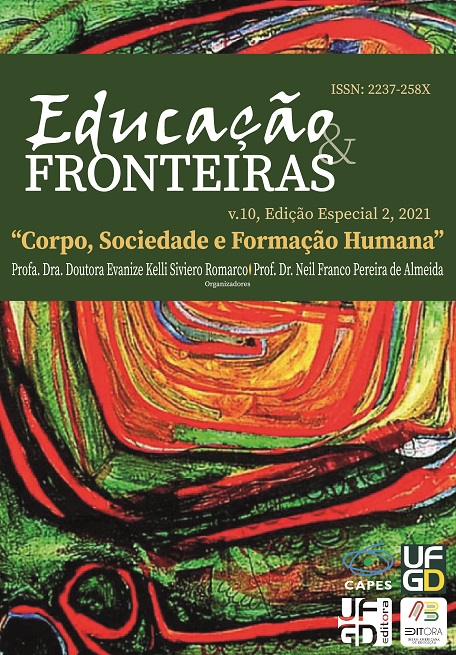The relevance of image and body movement in the process of learn and teach
DOI:
https://doi.org/10.30612/eduf.v11iesp.2.16482Keywords:
Imagem, Movimento, Ensino, Aprendizagem, FormaçãoAbstract
This study originated from the observations made by the authors about the different ways to understand the relevance of body image and movement in the process of Learning and Teaching. To contextualize this educational and somatic process, visual dynamics were applied to participants enrolled in the extension course Body, Human Education and Society - at UFGD, aiming to make the participant aware of everyone else's idea; identify, besides he diversity of ideas, many ways of seeing and thinking the same image or body movement, leading the participant to the development of his own thinking method or collective reflection, and ultimately to improve student participation and involvement . For this, we base ourselves on the theory of John Hattie (2017) about Visible Learning and we use the Zoom Thought Routine as a methodology. Four images were presented for observation and analysis, and after that, we asked 3 questions: What do you see? What do you think it could be? and What are your own inferences and conclusions from what you saw and thought? From the participants' reports, it was clear that the description and analysis of the images was be done through the knowledge repertoire of each learner. By listening to what is said, we get in touch with the learner's repertoire of words and thoughts, the way he acts and reacts to the situations presented there and the manner he resolves them. Observing the learner while performing the task, we notice attitudes that can be the hindering element of learning or even the reason for not learning. We analyzed how much this teaching-learning relationship was shown to be a reflection of the environment in which we live; that looking at learning is procedural and due to our heritage, we acquire knowledge, as well as transmit it, transforming ourselves into other “I's”. So, when we become other "I", the paths we choose, whatever it may be, will have a learning curve, which is marked in us, in our body and that these impressions should not be qualified as positive or negative, but as signs and signatures that they build us as a singular being. We know that such brands can help or harm us in our training processes, so it is necessary to find strategies to constantly dismantle stagnation tendencies, through self-transforming practices, to increase our creative potential and inspire us to constant changes necessary for our evolution.
Downloads
References
ABREU, Vinícius Cavalcante. Sobre a mania de querer mudar o outro. Multiverso Terapêutico, 1 mai0 2017. Disponível em: http://web.archive.org/web/20211020112238/multiversoterapeutico.com.br/2017/05/01/sobre-a-mania-de-querer-mudar-o-outro/. Acesso em:15 out. 2020.
ESCULTURA de Skakespeare. Low Cost Design, [s.d.]. Disponível em: https://www.lcdonline.com.br/escultura-shakespeare-dourado-envelhecido. Acesso em: 05 jun. 2021.
FERNÁNDEZ, A. O saber em jogo: A psicopedagogia propiciando autoria de pensamento. Trad. HICKEL, Neuza Kern. Porto Alegre: Artmed, 2010.
FURLAN, D. Esculpir o corpo. Denise Furlan, 2013. Disponível em: https://denisefurlan.wordpress.com/2013/02/05/esculpir-o-corpo/. Acesso: 05 jun. 2021.
GARCIA, J. O poder de gerir o eu. Jornal Entre Rios, 4 jan. 2020. p. VII. Disponível em: https://www.entreriosjornal.com.br/coluna-o-poder-de-gerir-o-eu-parte-vii-1276. Acesso em: 15 out. 2020.
HATTIE, J. Aprendizagem Visível para Professores: Como Maximizar o Impacto da Aprendizagem. Trad. Luís Fernando Marques Dorvillé. Porto Alegre: Penso, 2017.
JOLY, M. Introdução à análise da imagem. Lisboa: Ed.70, 2007.
KASTRUP, V. Políticas cognitivas na formação do professor e o problema do devir-mestre. Educ. Soc., Campinas, v. 26, n. 93, p. 1273-1288, set./dez. 2005. DOI: 10.1590/S0101-73302005000400010. Disponível em: https://www.scielo.br/j/es/a/bG374G5nJQ6jtVgCbb7Vsvb/?lang=pt. Acesso em: 10 abr. 2021.
LENCASTRE, J. A. N. Rotinas de pensamento: construindo uma cultura do pensar para o desenvolvimento da autonomia intelectual e moral. 2017. Monografia (Trabalho de Conclusão de Curso) – Faculdade de Educação, Universidade Estadual de Campinas, Campinas, SP, 2017.
MENDES, A. M. Metodologia para análise de imagens fixas. Belo Horizonte, MG: PPGCOM UFMG, 2019.
PICHÓN-RIVIÉRE, E. Processo Grupal. Trad. Marco Aurélio Fernandes Velloso e Maria Stella Gonçalves. 7. ed. São Paulo: Martins Fontes, 2005.
PROFESSORA na Pandemia (Stella Nicolau) - part. Felipe Bemol. [S. l.: s. n.]. 2020. 1 vídeo (3 min). Disponível: https://www.youtube.com/watch?v=ZzAYLN_atbE. Acesso em: 20 out. 2020.
PROJECTO ZERO. 2019. Disponível em: https://escolascritique.com.br/2019/05/02/conhecendo-o-projeto-zero-de-perto/. Acesso em: 05 ago.2021.
RITCHART, R.; PERKINS, D. Making Thinking Visible. Teaching Students to Think, v. 65, n. 5, p. 57-6, 2008. Disponível em: http://www.pz.harvard.edu/sites/default/files/makingthinkingvisibleEL.pdf. Acesso em: 03 ago. 2020.
ROLNIK, S. À sombra da cidadania: alteridade, homem da ética e reinvenção da democracia. Texto elaborado da fala proferida na mesa-redonda Cidadania e alteridade. In: ENCONTRO REGIONAL DE PSICOLOGIA SOCIAL DA ABRAPSO, 4., 1992, São Paulo. Anais [...]. São Paulo: PUCSP 1992. Disponível em: http://www4.pucsp.br/nucleodesubjetividade/Textos/SUELY/homemetica.pdf. Acesso em: 10 de set. 2018.
VISCA, J. Psicopedagogia e teoria da epistemologia convergente: Novas contribuições. Curitiba: Editora Intersaberes, 2020.
Published
How to Cite
Issue
Section
License
Copyright (c) 2022 Educação e Fronteiras

This work is licensed under a Creative Commons Attribution-NonCommercial 4.0 International License.









